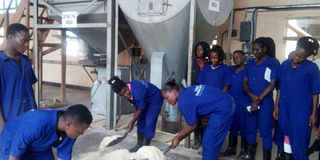Prime
What it takes to process animal, poultry feeds

Students mixing animal feed at Kabanyolo last week. Photo Lominda Afedraru.
Science experts in their wisdom say feed formulation for animals and poultry involves careful use of feedstuff for its nutrient content and feed ingredients to supply adequate amounts and proportions of the nutrients required.
It is important to note that because it is impractical to analyse each batch of feedstuff scientists usually compile the composition on the basis of laboratory analysis because the feedstuff composition vary for the various animal and poultry species.
Processing feeds
The nutrient value given is reflected on concentrations of products used to process the feed.
In a recent publication by the National Academies of Science and Engineering Medicine in the US about composition of feedstuffs used in feed composition, it is stated that in many instances, the food value has been changed to reflect results of analysis of feed ingredients obtained from contemporary crop cultivars and recently employed processing methods.
“From a nutritional point of view, there is no best diet formula in terms of ingredients that are used. The ingredients, therefore, should be selected on the basis of availability, price and the quality of the nutrients they contain. Certain ingredients invariably constitute the greatest part of diets in terms of both amount and cost,” reads part of the publication.
It is further stated that cereal grains and fats are the primary energy supplying ingredients and oilseed meals and animal-protein meals are used commonly as major source of amino acids which is a requirement for animal and poultry growth.
The feedstuff can be processed in mashed, pellets and flake forms depending on the demand.
As such scientists at Makerere University School of Agriculture and Environmental Sciences (CAES) and training agriculture students from various colleges and universities have embarked on processing animal and poultry feed at the feed mill based at Makerere University Agricultural Research Institute (MUARIK) Kabanyolo.
Seeds of Gold interviewed the participating students and the scientists and below are excerpts:
Animal feed content
Prof Noble Banadda, from CAES, who is on a mission of skilling students in agricultural engineering, innovations, crop agronomy and feed processing explains that feed nutrient content contains cereal grains, soymeal and animal protein which includes meat, fish and blood meal.
The food nutrient
Prof Banadda notes that globally many factors influence the food nutrient and in most cases it is meant for provision of amino acids for development of the animals and poultry.
The amino acid composition of grains and protein supplements are important for development of animals and poultry.
“For accurate and economic feed formulation, it is important for farmers to know the amino acid composition of actual ingredients to be used in the diet. However, it is generally not feasible to analyse all samples of feed ingredients prior to using it,” says Prof Banadda.
Therefore, researchers suggest that this can be analysed using laboratory analysis for the case of feeds processed by experts with availability of laboratory equipment for purposes of deterring the amino acid.
Other source of concentrates includes calcium, phosphorous and manganese which are important in animal and poultry diet concentration for specific macro minerals which may contain other nutritional elements such as chlorine, fluorine and sulphur.
What students are doing at MUARIK?
Daniel Tumusime a student from St Andrea Kaahwa Vocational Training Institute in Kakumiro District explains that the scientists at Muarik have taught them skills in mixing and milling feeds for animals mainly cattle, pigs and poultry.
The ingredients they are using includes, soybean concentrate, maize bran, salt, gastropod shells obtained from the shores of Lake Victoria and sunflower husks among others.
These can be mixed all at ago to get one concentrate.
Farmers can use the concentrate for feeding cattle, goats, sheep, pigs but the quantity given depends on the animal especially for calves it has to be different compared to grown cows.
The same applies to poultry. The concentrate size given to layers differs from broilers.
Storage, packaging and pricing
The location of the feed storage, handling and processing facilities on the overall feedlot site is critical. It must have ventilators and feed blocks must be kept under cool temperature.
The blocks must be kept on raised wooden structures but not on bare ground.
For the case of animals, the blocks can be hanged in the kraal for the animals to leak but for poultry they are mixed with water in liquid form which can be drunk
The pricing per kilogramme varies according the poultry and animal species. One kilogramme of broiler and layer feed is Shs1,500 whereas one kilogramme of piggery feeds will cost you Shs1,050. Dairy meal for calves and adult cattle costs between Shs1,000 and Shs1,050 respectively per kilogramme.
Storage tips
The process of storing and mixing feed is not as daunting as it may seem.
The basics of mixing and storing feed are the same as buying fodder and grain/ concentrates:
• Know what is in the feed before you buy it. Get a feed test.
• Store it in a way that you minimise spoilage and wastage.
• Make sure the ingredients fit your flexible feeding system
• Be aware of any potential hazards with certain types of feeds.




